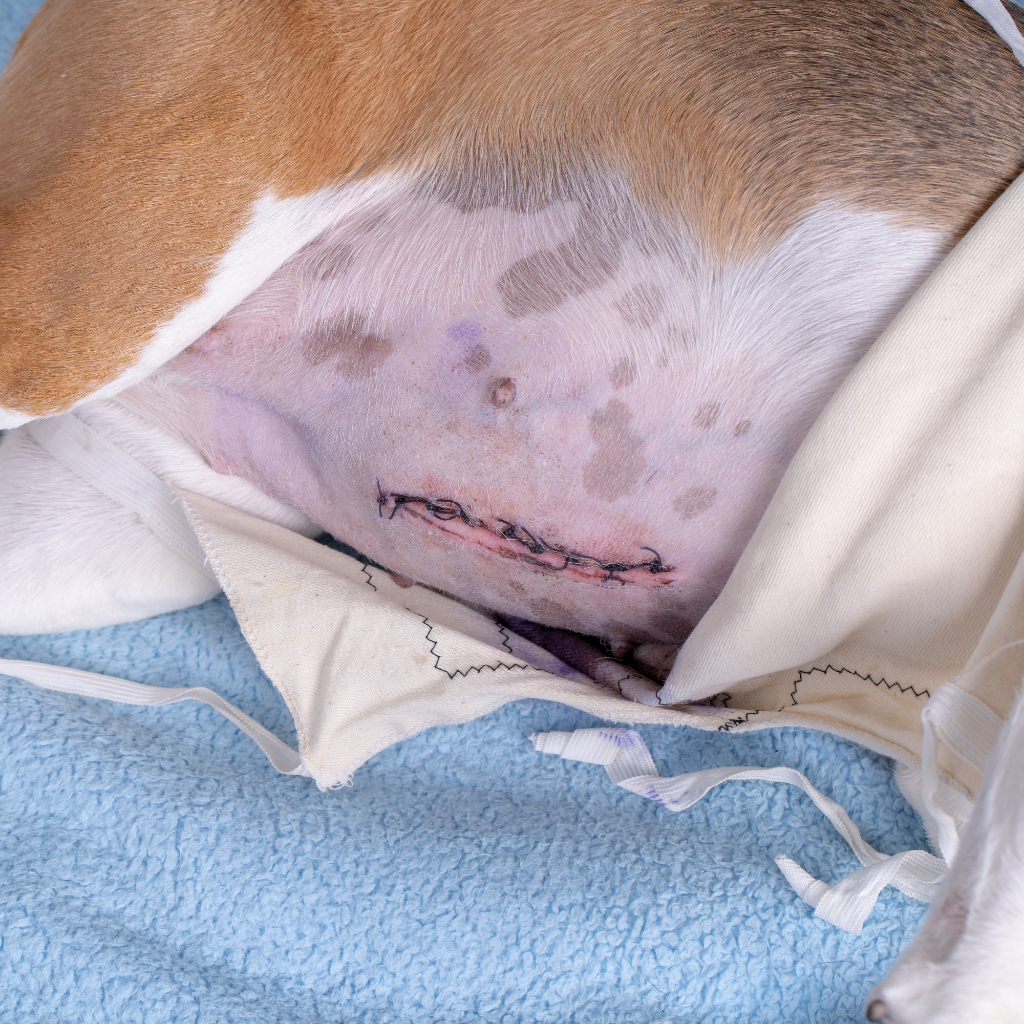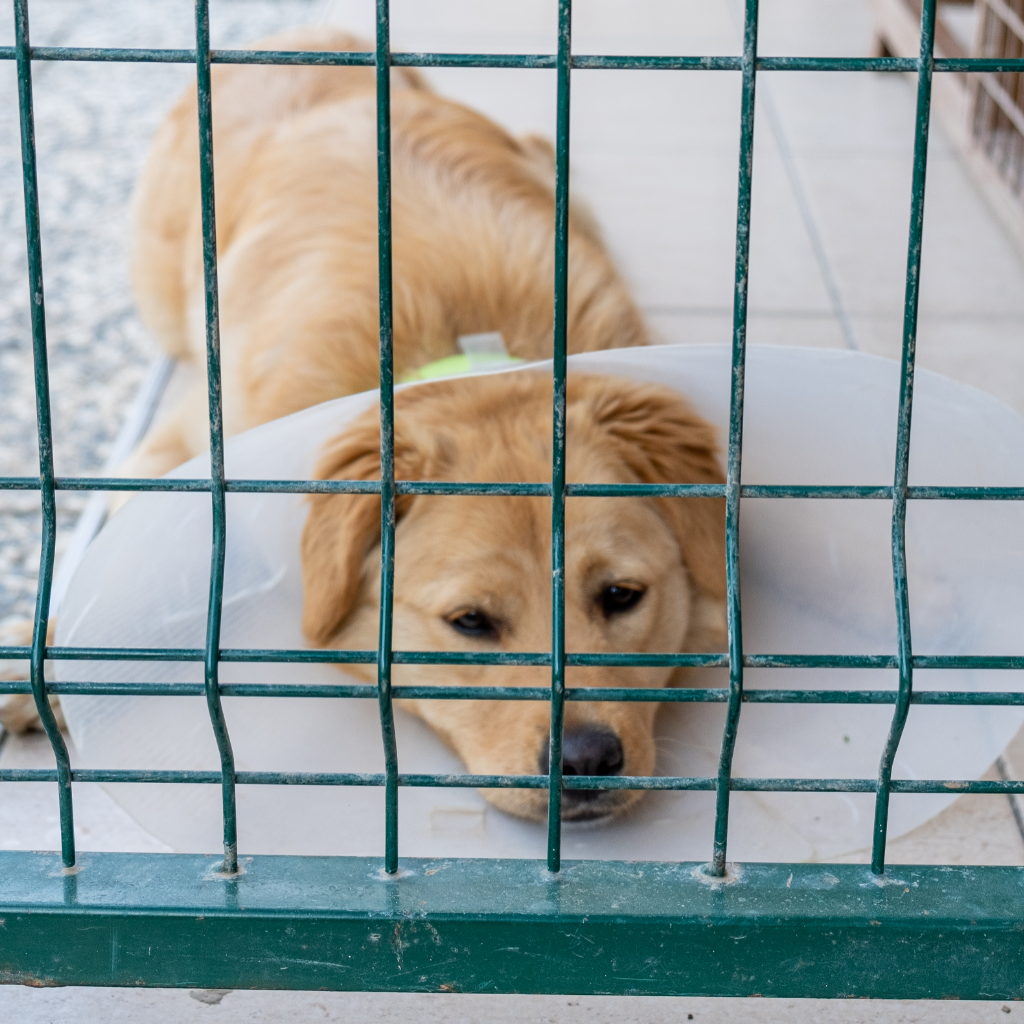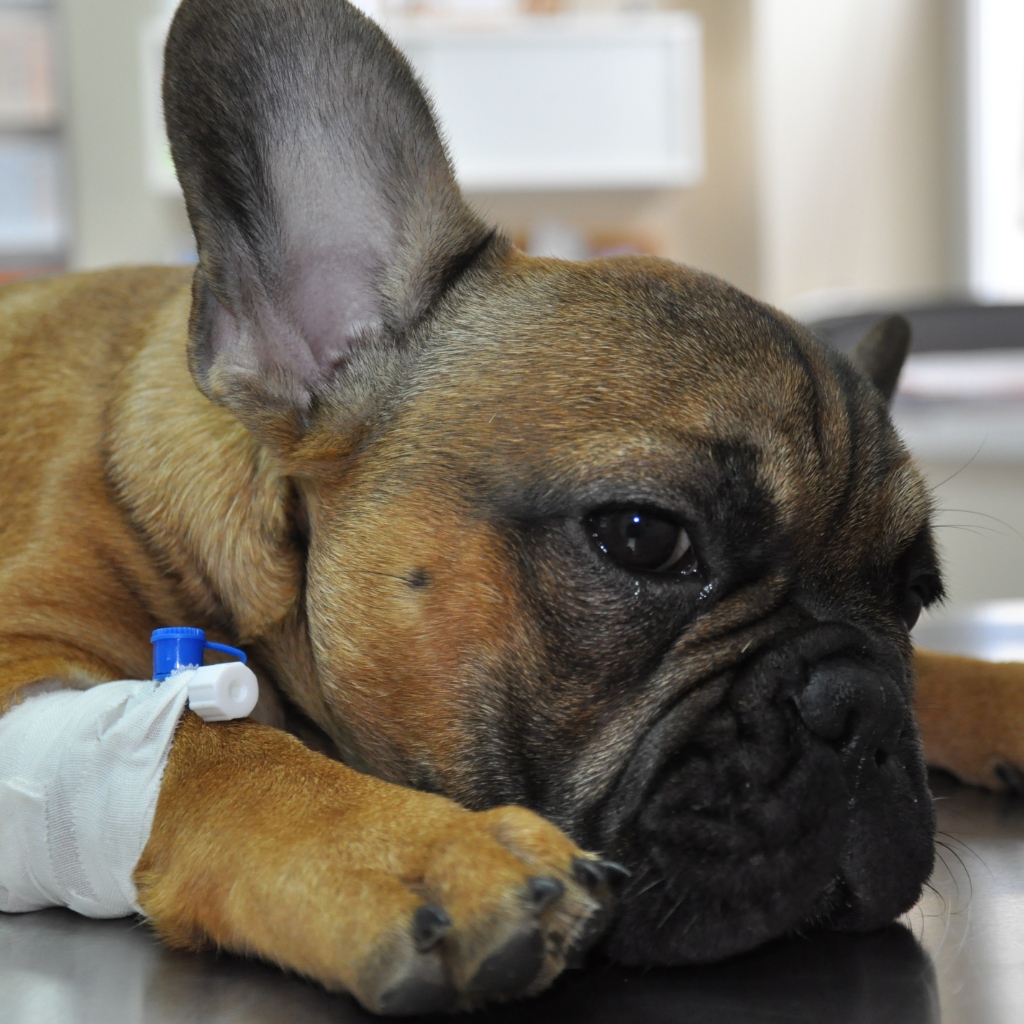At what age should you spay or neuter a dog?
Traditionally, vets recommended neutering or spaying dogs at the age of 6 months.
However, things have changed over the past decade, with many vets recommending early-age desexing (EAD) from the age of 8 weeks onwards.
There is considerable scientific evidence to suggest that EAD is a safe and effective strategy for the wider pet owners’ community to prevent unwanted/unplanned litters in cats and dogs.
However, desexing a dog at an early age is NOT recommended for large dog breeds who often take longer to reach skeleton maturity.
Table of Contents
ToggleDesexing A Dog – At What Age Should You Spay Or Neuter A Dog?
It is best to spay or neuter dogs at SIX months as it helps to eliminate heat periods and littering in females and pre-empt many behavior changes in males.
Some vets recommend desexing a dog earlier, but there are no documented benefits in the practice.
In most cases, it is much better to allow your dog’s liver and other organs that process anesthetics to mature before you schedule the procedure (most dogs would have reached that maturity level at six months).
However, some vets maintain that there is no one particular age that is ‘best’ for desexing a dog.
There are pros and cons to neutering or spaying dogs at different ages.
Always consult with your vet to evaluate the overall health of your pet and recommend the best age to neuter or spay based on the breed, size, and sex.
Overall, here are the pros and cons of desexing a dog at different ages to help you make an informed choice.
What is the Difference between Spaying and Neutering?
Many dog owners use the two terms interchangeably, which is not accurate.
Spaying refers to removing the ovaries and uterus of a female pet to prevent fertilization and eventual littering.
It is a simple veterinary procedure that requires minimal hospitalization and provides lifelong health benefits.
Neutering, on the other hand, refers to removing the testicles of a male dog to prevent them from mating and impregnating their “on-heat” female counterparts.
The procedure can also improve your pet’s behavior and safely tame him at home.
Reasons Why a Dog Should Be Spayed/Neutered
There are several important reasons for desexing a dog.
From a community point of view, desexing your dog prevents any accidental litter of puppies.
Each year, about 1.5 million pets are euthanized by shelters in the US (860,000 cats and 670,000 dogs).
This is in fact a declined from approximately 2.6 million dogs and cats euthanized in 2011.
This staggering number is definitely a very strong reason to desex all pets not meant for breeding!

Why Neuter Male Dogs?
Common reasons to consider neutering your male dog include:
- Prevents unwanted behaviors – It is quite common for intact male dogs to exhibit undesirable behaviors such as urine marking and humping.
- Reduces Escapes – Neutering eliminates the temptation for male dogs to escape whenever they smell a female in season.
- Increased lifespan of 9-12 months
- Eliminates or reduces risks of medical conditions such as prostatic enlargement, cystine bladder stones, testicular tumor, perianal tumor, and perineal hernia.
Why Spay Female Dogs
For female dogs, spaying offers the following benefits:
- Eliminates the situation where females drip blood around the house during their cycle.
- Increased lifespan of 9-12 months
- Eliminates heat periods and unwanted pregnancies
- Prevents pyometra (uterine infection)
Reasons NOT to Spay/Neuter a Dog
Apart from infertility, one of the proven negative side effects of spaying female dogs is an increased risk of urinary incontinence.
Male dogs may also have an increased risk of prostate and bladder cancer.
Other potential risks of desexing a dog include:
- Increased risks of overweight or obesity
- Higher incidence of cruciate ligament problems and hip dysplasia.
- Increased risk of certain cancers, such as haemangiosarcoma, lymphosarcoma, and mast cell tumor.
- Higher risk of prostate and bladder cancer in males.
- Increased risk of urinary incontinence in females.
The Compromise!
Although these side effects may sound scary, you shouldn’t be overly concerned about the various cancers associated with desexing.
There’s clearly a trade-off in reduced rates of other diseases such as prostatic enlargement, cystine bladder stones, testicular tumor, perianal tumor, perineal hernia, and uterine infections.
Moreover, desexing offers a moderate increase in the lifespan of both sexes (typically 9 to 12 months).
In other words, although desexing a dog may potentially result in some negative health effects, it significantly lowers the risk of many debilitating life-threatening diseases.

Benefits of Early-Age Dog Desexing (EAD)
Modern procedures of desexing a dog provide significant animal welfare benefits as compared to traditional age desexing.
Since the anatomical structures of younger pups are less developed, the desexing surgery is much faster and easier.
There is less tissue trauma or handling involved, and the surgery incision site is smaller, which minimizes bleeding.
The anesthetic recovery and wound healing times are equally shorter, providing further pet welfare benefits.
Scientific findings also indicate that EAD can significantly reduce the risk of mammary cancer in both cats and dogs.
These unique benefits are in addition to other commonly accepted benefits associated with desexing a dog, such as the reduction in roaming/wandering and undesirable sexual behaviors such as urine spraying and mounting.
Other benefits of desexing before the recommended age of 6 months include:
- Reduced risk of mammary tumors
- Less complicated, less expensive surgery
- Lower council rates for registering your pup
- Reduced chances of establishing sexual behaviors
- Reduced chances of accidental breeding
Potential Disadvantages to Early Age Desexing
Early age desexing poses some potential drawbacks, including:
- Increased risks of developing joint problems later in life (especially due to obesity).
- Heightened likelihood or severity of hormone-responsive incontinence.
- Increased anesthetic risk, particularly if the dog is neutered or spayed at a very young age.
Advantages Of Desexing A Dog Of Older Age
There are some advantages to desexing a dog at an older age (generally when the dog is skeletally mature, which is between 12 and 24 months depending on the breed).
Neutering at 12 months is often recommended for dog breeds prone to hip dysplasia and cruciate disease.
New findings, however, suggest that 6 months is still OK for male Labradors and other giant breeds.
Later spaying may also benefit females with urinary incontinence.
For medium-sized breeds, vets recommend waiting until at least 9 months (particularly for dogs weighing 15 kgs and above adult bodyweight.
Dachshunds should be desexed later to minimize the risk of IVDD.
Female dogs with a deeply recessed private parts should be allowed to have a season to lower the risk of perival dermatitis when they turn into adults.
After a season, it’s best to wait for at least 2 months to allow everything to settle down before scheduling a surgery.
Other pros of desexing a dog of older age include:
- Reduced risks of joint disease
- Reduced risks of certain tumors
Disadvantages Of Old Age Desexing
Desexing a dog at an older age can have some negative effects, including:
- Surgery is more difficult with increased costs and longer recovery times.
- Your dog would have established some undesirable sexual behaviors that will be difficult to reverse.
- Greater chances of accidental litters.

The Best Age To Spay/Neuter A Dog by Breed
Although it is widely acceptable to spay or neuter your pooch at an age of six months, scientific evidence shows that different dog breeds respond differently to desexing.
It is a wise idea to discuss with your vet about the right age to desex your specific breed to minimize risks of negative health effects.
Two studies published in 2020, 39 pure breeds and mixed breeds of various sizes were monitored to determine the best age for neutering/spaying.
The scientists looked at the rate of cancers, joint problems, and urinary incontinence at different neutering/spaying ages.
In the table below, we have picked the best neutering/spaying age that reduces many health problems recorded for each breed.
| No | Dog Breed | Best Male Neutering Age (Months) | Best Female Spaying Age (Months) |
| 1 | Australian Cattle Dog | 9 | 9 |
| 2 | Australian Shepherd | 9 | 9 |
| 3 | Beagle | 9 | 9 |
| 4 | Bernese Mountain Dog | 24 | 12 |
| 5 | Border Collie | 12 | 12 |
| 6 | Boston Terrier | 6 | 6 |
| 7 | Boxer | 9 | 9 |
| 8 | Bulldog | 6 | 6 |
| 9 | Cavalier King Charles Spaniel | 6 | 6 |
| 10 | Cavoodle sized dogs | 6 | 6 |
| 11 | Chihuahua | 6 | 6 |
| 12 | Cocker Spaniel | 9 | 9 |
| 13 | Collie | 9 | 9 |
| 14 | Corgi | 9 | 9 |
| 15 | Dachshund | 12 | 12 |
| 16 | Doberman | 9 | 24 |
| 17 | English Springer Spaniel | 9 | 24 |
| 18 | German Shepherd | 12 | 12 |
| 19 | Golden Retriever | 12 | 12 |
| 20 | Great Dane | 9 | 9 |
| 21 | Irish Wolfhound | 9 | 9 |
| 22 | Jack Russell Terrier | 6 | 6 |
| 23 | Kelpie sized dogs | 9 | 9 |
| 24 | Labrador | 6 | 12 |
| 25 | Large breeds (other) | 12 | 12 |
| 26 | Maltese | 6 | 6 |
| 27 | Miniature Schnauzer | 6 | 6 |
| 28 | Pomeranian | 6 | 6 |
| 29 | Toy Poodle | 6 | 6 |
| 30 | Miniature Poodle | 12 | 6 |
| 31 | Standard Poodle | 9 | 9 |
| 32 | Pug | 6 | 6 |
| 33 | Rottweiler | 12 | 12 |
| 34 | St Bernard | 9 | 9 |
| 35 | Staffy sized dogs | 12 | 12 |
| 36 | Sheltie | 6 | 24 |
| 37 | Shi Tzu | 6 | 6 |
| 38 | West Highland White Terrier | 6 | 12 |
| 39 | Yorkshire Terrier | 6 | 6 |
Other Insights From The Evidence
From these studies, it is clear that early age desexing (EAD) increases the risk of joint diseases in some dog breeds.
However, the argument regarding the risk of cancers is less certain.
According to scientists, hormones influence the normal development of joints in certain breeds.
Once joints have fully grown, hormones shouldn’t make any significant difference.
One notable problem is that none of these observational studies was controlled for body weight.
The desexed group is almost certainly heavier, and we all know that weight is a huge risk factor for hip dysplasia (HD) and cranial cruciate ligament disease (CCLD).
Dog Desexing Procedure
So, what is involved in desexing a dog?
There are basically two ways to desex a dog: surgical desexing and chemical desexing – the most common methods being surgical desexing.
When a dog is desexed through a surgical means, it requires full anesthesia.
For female dog spaying, a qualified vet will surgically remove the entire reproductive system (the uterus or womb, ovaries, and fallopian tubes).
It is also technically possible to “tie off the tubes” in female dogs, the same way it is done in women for birth control.
While this approach is effective in stopping the female from conceiving, it leaves behind the ovaries, so she will still come into heat and retain all the risks of mammary cancer.
It also leaves behind the uterus with all the attendant risks of pyometra.
A better approach is to remove the entire reproductive organs by cutting through a small incision in the midline of her abdomen.
Some vets can use laparoscopic surgery, but that always requires at least three abdominal incisions.
In most cases, it results in larger incisions than the single incision that experienced surgeons require for conventional surgery.
Male dog neutering is a much simpler procedure.
It is essentially a skin incision done to remove the testicles of your male dog.
Most male dogs trot out of the clinic later that day as if nothing ever happened!
Chemical Desexing
Both male and female pups can be rendered temporarily infertile by medical means.
There are various tablets that your vet can give to your female dog to delay or suppress heats.
However, these pills are rarely used today since they have unwanted side effects and can cause diabetes.
They can also interfere with future fertility if you plan to breed from your female dog.
Other than surgical neutering, there are hormonal implants available for male dogs known as Suprelorin (Virbac) that last either 6 months or 12 months.
These implants can be costly, and there is a potential for some dogs to develop permanent infertility, so they are not recommended if you intend to breed from your dog in the future.
Common side effects of hormonal implants include occasional mild swellings at the implant site, which often resolves naturally.
Overall, hormonal implants are not recommended for dogs that are yet to reach puberty.

Dispelling The Myths About Spaying Or Neutering Dogs
Myth #1 – Neutering Solves Aggression
While it is true that desexing a dog can in very rare occasions reduce aggression, temperament is inherited, and desexing alone may not reverse your dog’s aggression.
You need to identify the underlying cause of aggression and manage the problem through proper training.
Myth #2 – Vets Promote Desexing Because They Want To Make Money
There is much more cash to be made through complex pyometra surgeries and cesarean than from routine desexing.
If veterinarians wanted to cash more from pet owners, they would strongly oppose desexing and vaccinating.
That way, your accidental litters and unvaccinated pups will create more opportunities to make money in care and treatment.
Female Dog Reproductive Cycles
If a female dog is spayed, she cannot conceive or give birth to puppies.
However, a female dog must first come “on heat” or “into season” before she is mated.
In between heats, the female experiences reproductive inactivity, and she won’t be sexually receptive to males.
During this period, blood flow to her reproductive organs is minimal and hormone levels are at their lowest.
Coming On Heat
As the female is about to come into heat, her body releases massive surges of hormones, which can often affect her temperament – just like PMS can in some women!
In the early stages of coming on heat, the female bleeds from her private parts and becomes very attractive to male dogs.
It is surprising that a male dog can scent a female on heat from several miles away.
Multiple male dogs will soon be lining up at your yard wanting to present their credentials to your girl.
In the early and later stages of her 3-week long heat, the female will not be that keen on male dogs.
But during the middle week up to 10 days of the heat, she will become as amorous as the males, and it is at this point that she is most at risk of getting pregnant.
For the entire period that the female comes on heat, there are massive changes to her body’s development.
The high hormone surges in the bloodstream will stimulate the ovaries to mature and release eggs.
The activity in the uterus (womb), as well as the mammary (breast) tissue, will be massive, readying both for potential fetus implantation and milk production.
False Pregnancies in Female Dogs
As soon as the signs of the heat vanish, virtually every female will exhibit some degree of “false pregnancy” even if she was not mated.
The false pregnancy may be mild and difficult to notice, but the hormones associated with coming on heat would have prepared her uterus and mammary tissues for pregnancy and lactation.
Some female dogs, especially those that are well cherished, can have a full-on false pregnancy and begin to make milk, make nests, or steal slippers and soft toys as “false puppies.”
They can with all intent rear a litter of soft toys, with some even going into false labor.
This false pregnancy can be extremely distressing to both the owner and the dog herself.
At the end of the false pregnancy, her hormone levels wane, causing the mammary and reproductive tissues to become less active until her next reproductive cycle.
Male Dog Reproductive Activity
Although male dogs do not have a reproductive cycle parse, they often have varying levels of hormones in response to the presence of a potential mate.
When your male dog scents a female on heat nearby, his body will release more hormones to stimulate the production of more seeds.
These hormones also bombard his prostate, making the organ bigger as well.
The principal hormone in a male dog is testosterone, which is also responsible for his body changes and can affect his temperament.
Both male and female dogs mature to the point of engaging in sexual activity at about 6-12 months.
As a rule of thumb, smaller breeds enter “puberty” at an earlier age as compared to larger breeds.
Caring for A Neutered/Spayed Dog
The procedure of desexing a dog is performed under a general anesthetic.
While desexing is a fairly common and safe procedure, keep in mind that the process is surgical.
Spaying female dogs, in particular, involves massive intra-abdominal surgery.
Your pup’s recovery will largely depend on the aftercare you provide, so it is important that you make them feel as comfortable as possible through this healing process.
With the right aftercare, your dog should remain safe and comfortable and minimize the risks of infections or other health issues arising.
Anesthetic
The anesthetic administered to your dog during desexing will typically not wear off until a few hours after the procedure, and it can sometimes last overnight.
However, if your pooch is still drowsy and lethargic 24 hours after the surgery, please contact your vet immediately for a follow-up checkup.
Surgical Site
For both male and female dogs that have just been desexed, you must continue inspecting their wound every day for the next 10-14 days.
Look out for discharges, missing sutures, or swelling and notify your vet if any of these issues occurs.
If your vet used dissolvable skin sutures, your pet won’t need suture removal.
Either way, they will require a vet checkup after 10-14 days to ensure that the wound is healing well.
This is often a free appointment that you can book anytime.
Caring For The Wound
Some dogs will constantly leak their wounds, which can cause further damage.
To prevent your dog from irritating their wound or chewing through their sutures, you should get a Protective Inflatable Collar.
Do not bathe your dog or wet the surgical site in any way for 10-14 days after the surgery as this can cause problems and delay the healing.
Food And Water
After the surgery, your dog is free to eat and drink as normal.
However, some dogs may experience nausea and a loss of appetite due to the anesthesia and other medications used in the surgery.
If your pooch is vomiting or refusing to eat as usual, please consult your vet.
Rest And Exercise
After your dog is desexed, encourage them to rest as much as possible to speed up their healing process.
This is the time to limit exercise and avoid any strenuous activities such as climbing stairs, rough play, or jumping up and down couches or beds.
Some pets may need to be restricted within a small room or crate so they do not strain their wound.
You may take your pup outside for short walks while on a lead, but try to limit such to toilet trips only.
Warning Signs To Look Out For:
Call your vet immediately for advice if you notice any of the following signs:
- Swelling or bleeding around the wound area.
- Your dog is constantly licking the wound, or the wound appears red and angry.
- Your dog is not responding to treatment as you anticipated.
- You need to bathe your pet or treat them for fleas before the stitches are removed.
- You have any concerns about your dog’s health after desexing.

How To Prevent Unhealthy Weight Gain After Spaying/Neutering
A common fallacy is that a desexed dog gets fat and lazy.
The truth is, a desexed dog has lower energy requirements.
They make more efficient use of their food since the food is not diverted into hormone production, neither is it utilized in growing the uterus and mammary tissues and all other heat-related activities in females.
So, don’t continue to feed the same quantity of food as you did prior to spaying.
She will store away the extra food as fat.
The same applies to every pet as it matures.
The daily energy requirements will gradually drop and, unless you lower their energy intake, they will certainly grow fat and develop joint-related issues.
Final Thought…
Overall, desexing a dog that is not meant for breeding will give them a greater chance of living a longer and healthier life.
Your desexed dog will not be distracted by the entire breeding cycle, will be at their best behavior, and will integrate more easily into your household.
The best age to desex a dog is at SIX months, and a quick day in the hospital will give your furry friend a lifetime of health and behavioral benefits.
Be cautious, however, with large breeds, and always consult your vet to determine the right age for neutering/spaying.
Frequently Asked Questions:
At what age should you spay a dog?
Generally, it is advisable to spay a female dog before puberty (around 6 months of age).
This eliminates the problems of cautiously watching a female in season and reduces the risk of unwanted pregnancies.
However, before desexing a dog, vets often recommend allowing a female dog to experience one heat season before spaying to reduce risks of perival dermatitis when they turn into adults.
What is the right age to neuter a dog?
For male dogs, while the traditional age for neutering is 6-9 months, puppies as young as eight weeks old can be safely neutered as long as they’re healthy.
There is, however, an exception for large breeds that often have orthopedic joint problems – neutering should wait until the dog has reached skeleton maturity.
Do dogs change after being desexed?
Both male and female dogs that are desexed often have a more relaxed temperament since they are not as driven by their hormones.
However, you can expect your pet to remain as loving and loyal as before.
The most common behavioral change after desexing is reduced aggression.
What do they do when Desexing a female dog?
The procedure for spaying female dogs involves the removal of the dog’s uterus and ovaries.
Since it’s a major surgical procedure, spaying is done under full anesthesia and requires hospitalization.
Why you shouldn’t neuter your dog?
Some studies indicate that male dogs who are neutered have an increased risk of developing other orthopedic diseases.
The potential for cruciate rupture and hip dysplasia rises when a male dog is not allowed adequate time to fully hormonally grow and develop healthy bones.
Neutering male dogs may also increase the risk of cardiac hemangiosarcoma.
What happens if you don’t neuter your dog?
Failure to neuter your dog means that they will produce excessive testosterone, which can trigger aggressive tendencies, especially if your male pooch is alpha in nature.
Excessive testosterone levels can be dangerous for any domesticated pet.
